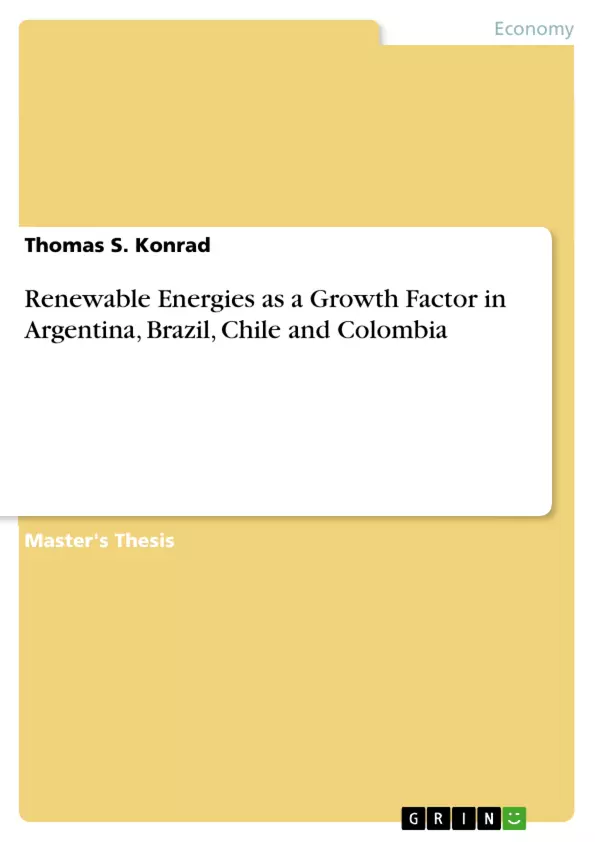This present empirical Master thesis deals with renewable energies as potential growth factor in emerging countries in the context of sustainable economic development. The geographical focus is placed on South America. The sample embraces Argentina, Brazil, Chile and Colombia whose energy markets are interrelated through historical and political commonalities which at the same time constitute collaboration obstacles in energy trade. The concrete research question is whether renewable energies can act as an acceleration factor upon the development of emerging South American economies and refers to the assumption that renewable energies may contribute to economic growth.
Following a substantive literature review eight hypotheses were formulated and verified by means of multivariate regression models including different checks and tests regarding: significance of the coefficients (p-value), significance of the regression model (F-Test), autocorrelation (Durbin-Watson-Test), multicollinearity (VIF value), heteroscedasticity (Goldfeld-Quandt-Test), and structural break (Chow-Test). Empirical input data were gathered from publicly available sources, such as the IEA and the World Bank. The results are transparently visualized by numerous figures and tables.
In general, the results indicate the existence of positive and negative relations between various dependent and independent variables related to macroeconomic and renewable energy proxies which were used for the forming of hypotheses. Finally, the empirical data gathered in present study provide sufficient evidence to conclude that renewable energies act as an important acceleration factor for the development of the economies of Brazil, Chile and Colombia. In the case of Argentina, a sufficient amount of significant results could not be obtained to make a judgment with respect to the research question.
Inhaltsverzeichnis (Table of Contents)
- 1 Introduction
- 2 Literature Review and Deduction of Hypotheses
- 2.1 Literature Review
- 2.1.1 Overview of the literature reviewed
- 2.1.2 Conclusion on the literature reviewed
- 2.2 Hypotheses
- 2.2.1 Hypothesis 1
- 2.2.2 Hypothesis 2
- 2.2.3 Hypothesis 3
- 2.2.4 Hypothesis 4
- 2.2.5 Hypothesis 5
- 2.2.6 Hypothesis 6
- 2.2.7 Hypothesis 7
- 2.2.8 Hypothesis 8
- 2.3 The sample of countries
- 2.3.1 Argentina
- 2.3.2 Brazil
- 2.3.3 Chile
- 2.3.4 Colombia
- 2.4 Interrelations and integration obstacles of the four energy markets
- 2.1 Literature Review
- 3 Empirical Analysis – Interconnection between Renewable Energies and Economic Growth
- 3.1 Depiction of the sample and methods of data collection
- 3.2 Implementation of the sample
- 3.2.1 Selection of variables and parameters
- 3.2.2 Applied analysis methods and their boundary conditions
- 4 Results
- 4.1 Hypothesis 1
- 4.2 Hypothesis 2
- 4.3 Hypothesis 3
- 4.4 Hypothesis 4
- 4.5 Hypothesis 5
- 4.6 Hypothesis 6
- 4.7 Hypothesis 7
- 4.8 Hypothesis 8
- 5 Discussion
- 5.1 Discussion of the results
- 5.2 Theoretical and practical implications of the results
- 5.3 Limitations
Zielsetzung und Themenschwerpunkte (Objectives and Key Themes)
This research aims to examine the relationship between renewable energy development and economic growth in four emerging South American economies: Argentina, Brazil, Chile, and Colombia. The study explores the impact of renewable energy on economic growth, focusing on the role of hydropower, wind, and solar energy. The research also investigates the interrelations and integration obstacles of the four energy markets. The key themes of the study include:- The impact of renewable energy on economic growth in emerging South American economies.
- The role of hydropower, wind, and solar energy in driving economic development.
- The interrelations and integration challenges of the energy markets in the four countries.
- The analysis of specific hypotheses related to the relationship between renewable energy and economic growth.
- The discussion of theoretical and practical implications of the research findings.
Zusammenfassung der Kapitel (Chapter Summaries)
- Chapter 1: Introduction: Provides an overview of the research topic, its significance, and the research questions. It outlines the objectives and methodology of the study.
- Chapter 2: Literature Review and Deduction of Hypotheses: Presents a comprehensive review of relevant literature on renewable energy and economic growth. It deduces and formulates specific hypotheses to be tested in the research.
- Chapter 3: Empirical Analysis – Interconnection between Renewable Energies and Economic Growth: Describes the sample of countries selected for the study, the data collection methods, and the analytical techniques employed. It also defines the variables and parameters used in the analysis.
- Chapter 4: Results: Presents the results of the empirical analysis, focusing on the findings related to each hypothesis formulated in Chapter 2. It analyzes the impact of renewable energy on economic growth, considering the specific types of renewable energy and the individual characteristics of the four countries.
- Chapter 5: Discussion: Discusses the implications of the research findings, both theoretical and practical. It explores the significance of the results for policymaking and future research directions. It also acknowledges the limitations of the study.
Schlüsselwörter (Keywords)
The main keywords and focus topics of this research include renewable energy, economic growth, emerging economies, South America, hydropower, wind energy, solar energy, energy markets, interrelations, integration obstacles, empirical analysis, hypotheses, and policy implications.- Quote paper
- Thomas S. Konrad (Author), 2012, Renewable Energies as a Growth Factor in Argentina, Brazil, Chile and Colombia, Munich, GRIN Verlag, https://www.grin.com/document/369520



